Wandsworth House of Correction / HMP Wandsworth, London
In 1847, a committee of Surrey magistrates concluded that the shortage of cells in the county necessitated the construction of a new House of Correction. A 26-acre site was found at the west side of Heathfield Road, Wandsworth and purchased at a cost of £300 and acre. Mr D.R. Hill of Birmingham was commissioned to draw up plans for the prison to house 708 inmates, operated on the separate system, and capable of being enlarged to hold 1,000 prisoners. Building work began in the spring of 1849, with the first male prisoners being admitted in 1851 and the first female prisoners in 1852.
In 1858, it was decided to add a new wing to the main building to accommodate an additional 250 male prisoners. There was also to be a new prison for females, while juvenile offenders were to be removed to a reformatory school.
The prison site is shown on the 1862 map below.
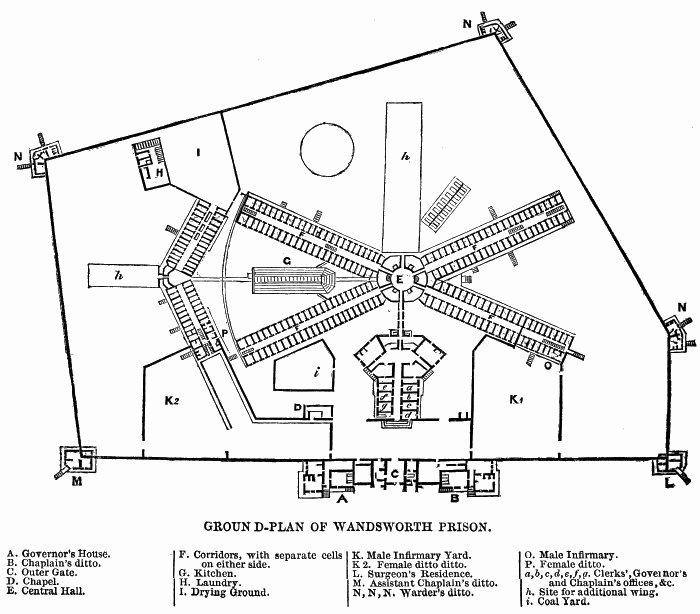
Wandsworth Prison site, London, c.1862.
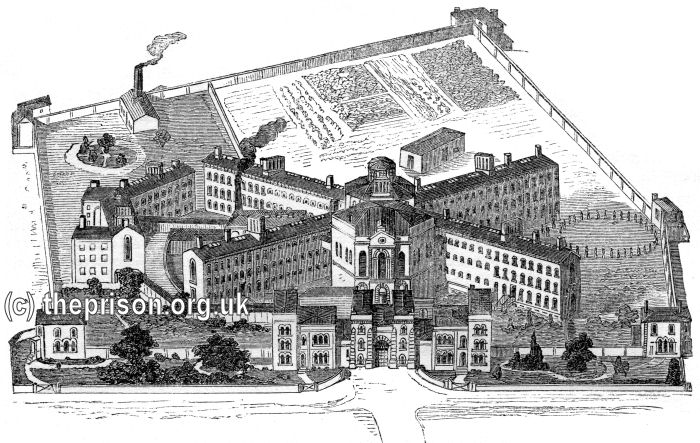
Wandsworth Prison, London, c.1862. © Peter Higginbotham
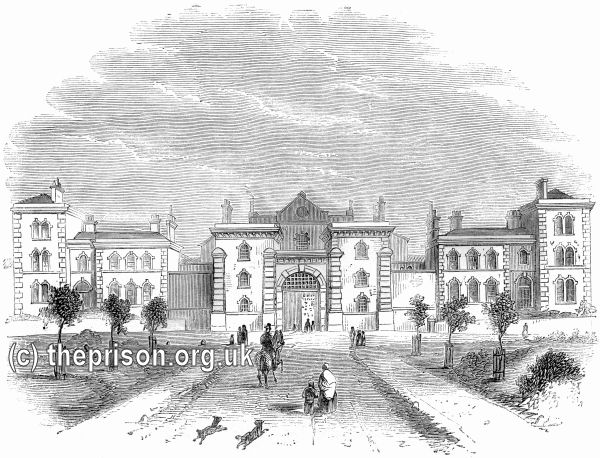
Wandsworth Prison entrance, London, c.1862. © Peter Higginbotham
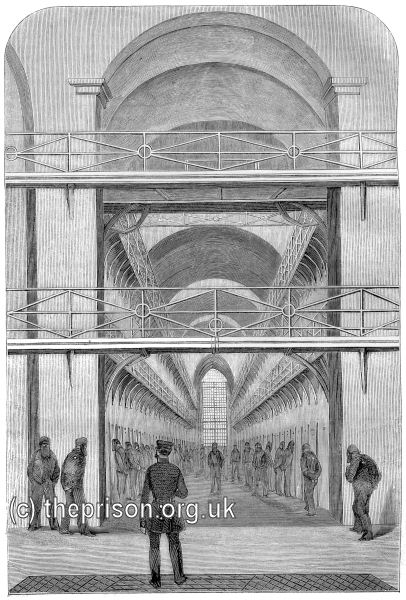
Wandsworth Prison cell wing, London, c.1862. © Peter Higginbotham
Visitors to the prison in 1862 described the inmates' accommodation:
There are no dormitories and no associated rooms here, as in several of the other metropolitan prisons. The prisoners are all confined in separate cells. On proceeding with the chief warder into a cell in one of the corridors, we found its dimensions to be 13 feet long, by 7 feet wide, and 9 feet high. In size and arrangements it is exactly similar to the others along the various corridors, and is very nearly as large as the model cells at Pentonville, also on the separate system, the latter being 131 feet long by 73 feet broad, and 9 feet high.
The furniture consists of a small deal table, an earthenware night-utensil or water-closet, covered with a wooden lid, which serves, as we have already said, as a seat to the prisoner, and a small metal water box fitted into one of the corners of the cell. "By a water box," said the chief warder, "I do not mean that it contains water, but is a shield for the water tap, to prevent the prisoners tampering with it." The water pipe communicates with the night utensil and washing bowl, There is a gas jet in each cell. In a corner beside the door there are three small shelves. On the upper one generally rests the bedding, rolled up like a lady's muff, as seen in the engraving. On the other shelves are a tin plate, a shining tin pannikin, a wooden spoon, a wooden salt cellar, two combs, a brush, and soap box, with a Bible and prayer book, and one or more library books. The bedding consists of a canvas hammock, a coverlet, two blankets, and one pair of sheets. There are two iron hooks on each side of the cell, on which the hammock is suspended. The bed clothes are all marked with the prison mark.
A copy of the rules of the prison is suspended on the wall, and a list of the dietary prescribed to prisoners by the order of Government. We also see suspended a card containing the prisoner's name, offence, sentence, date of admission, expiration of sentence, his trade, and previous committals (if any).
In each cell is a bell-handle, by which the prisoner is able to communicate his wants to the officer. This bell-handle communicates with the metal plate outside the wall of the cell in the passage, on which is printed the number of the cell. There is an inspection opening in the door of the cell, covered with glass and protected with a light wire screen, and also an aperture for receiving the food, &c., as in the reception cells.
Here we took particular notice of the dress worn by the prisoners. The clothing in this correctional prison consists of a dark-gray jacket, vest, and trousers, a blue striped cotton shirt, a pair of worsted stockings, a pair of shoes, a stock made of the same materials as the jacket, a pocket handkerchief, flannel shirt and drawers, and a gray cap of the same description as the clothes, with a mask covering the face, having eyelet-holes. A piece of alpaca is inserted over the mouth for freer respiration.
The work provided for male inmates in their cells included oakum picking, mat-making, netting, tailoring, and shoe-making. All the prison shoes were made by inmates. Outside occupations included gardening, brick-laying, painting and cleaning. The employment for female prisoners consisted of work in the wash-house and laundry, picking coir, needlework, and cleaning. Male inmates undergoing a sentence with hard labour were put to a crank machine, of which the prison had 100. When such prisoners first came into the prison they were kept at a machine (making 15,000 revolutions per day) for between one and three months depending on the length of their sentence and the need for transferring them to make room for newcomers when the rate of admissions was high. From the machines they were transferred to the pumping house or to work the flour-grinding mills, where they remained for a limited period; after which they were employed in the garden, or at trades, or at work about the prison, or in picking oakum.
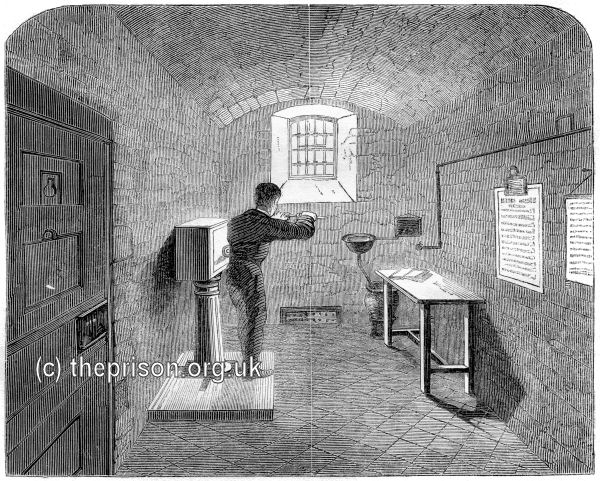
Wandsworth Prison crank turning, London, c.1862. © Peter Higginbotham
The prison's water was originally drawn from an artesian well, 480 feet deep, immediately beneath the pump-house. Between 5000 and 6000 gallons of water were pumped daily during working days and stored in the prison's main cistern.
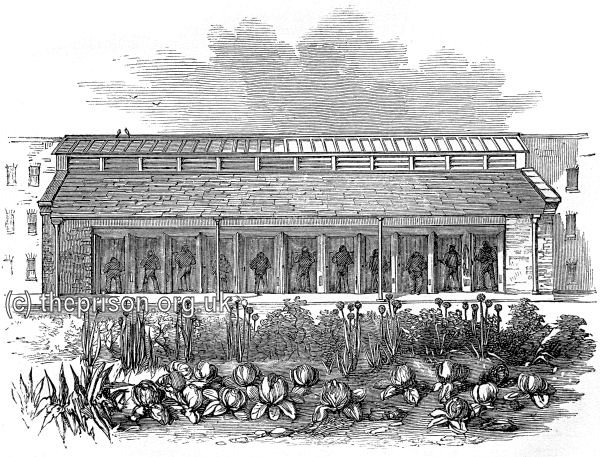
Wandsworth Prison water-pumping room, London, c.1862. © Peter Higginbotham
The prison had fourteen punishment cells, seven of which were lit by a small iron-framed window, the others being completely dark. The furniture of these cells consists of an iron bedstead, fixed to the floor, and a water-closet. There was also a bell to communicate with an officer in case of sickness, and a trap in the door to convey food as in the other cells . While confined here, prisoners are kept on bread and water. The bedding at night consisted of a straw mattress, two blankets, and a rug handed in at 9 p.m., and taken away in the morning, when a tub of water was provided for washing. Prisoners could be placed in a punishment cell for offences such as: shouting in their cell; exposing their features; refusing to work; insolence to an officer; idleness at a hard-labour machine, and talking at exercise. Offences by females included eating soap, which was sometimes done to get on the sick-list, and have better diet, or to be relieved from labour.
The prison also had a whipping-post where occasionally, by an order of magistrates, juvenile criminals were flogged with a birch rod.
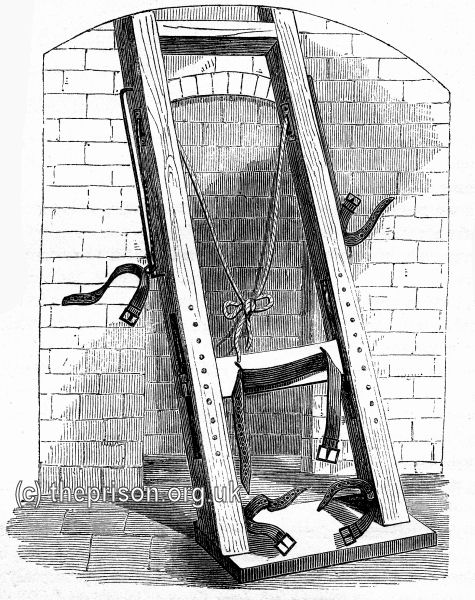
Wandsworth Prison whipping post, London, c.1862. © Peter Higginbotham
In the prison chapel, the seats were partitioned so as to prevent communication between the inmates. As well as religious services, it was used as as a school room for adult prisoners. The juvenile inmates had a separate school room.
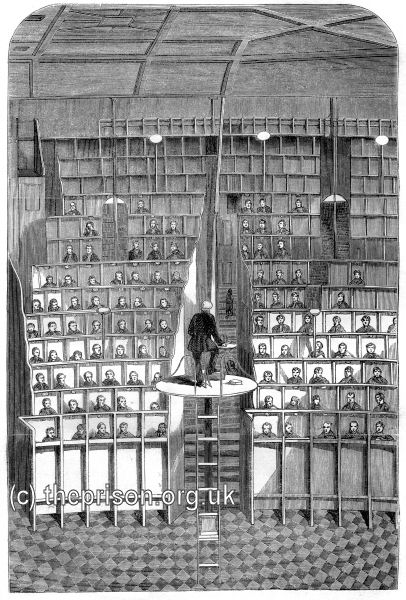
Wandsworth Prison adult school in chapel, London, c.1862. © Peter Higginbotham
When the prison system was nationalised in 1877, Wandsworth became a short-term prison and also replaced Horsemonger Lane as the hanging prison for South London. It came to be used for recidivists (repeat offenders).
After the First World War, part of the prison was taken over as the Boys' Prison for London, under a separate governor and regime from the main block. Boys were assessed here and, if appropriate, allocated to Borstals. In 1929, this function was transferred to Wormwood Scrubs. In 1931, however, a special wing at Wandsworth was converted for use as the Wandsworth Borstal.
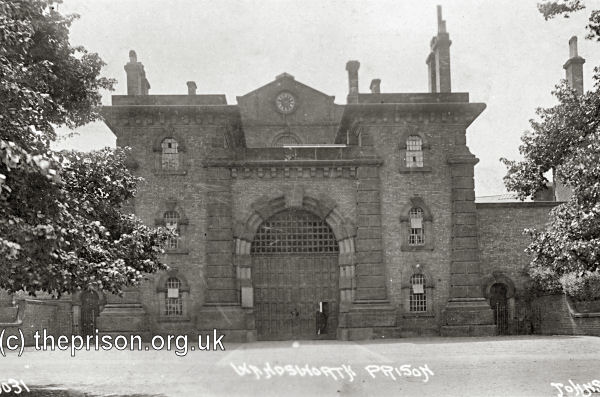
Wandsworth Prison, London, early 1900s. © Peter Higginbotham
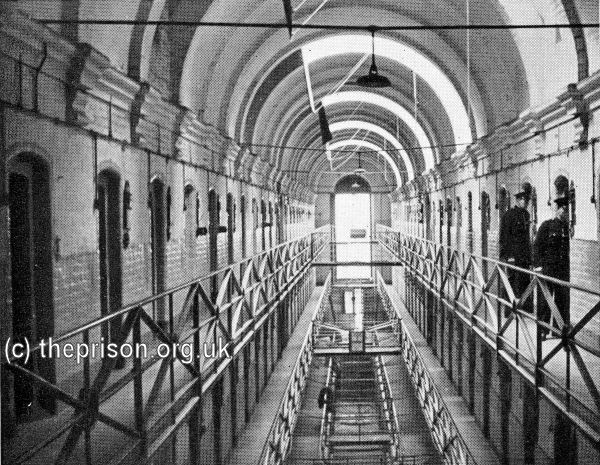
Wandsworth Prison cell wing, London, c.1945. © Peter Higginbotham
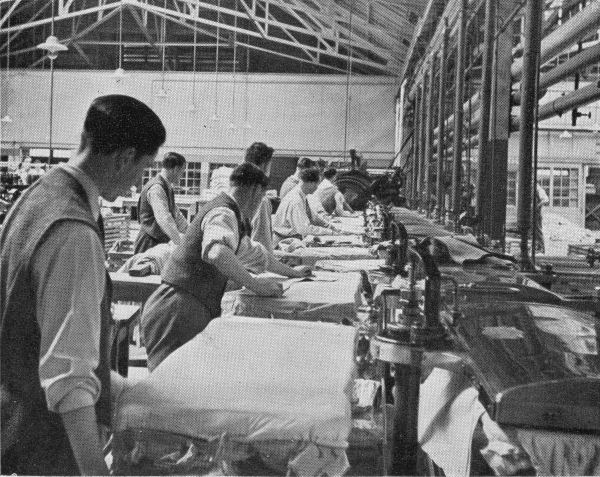
Wandsworth Prison laundry, London, c.1945. © Peter Higginbotham
In more recent times, the prison has been used to hold convicted persons awaiting sentence and as the centre for allocating long-term prisoners to other prisons outside the London area.
Records
Note: many repositories impose a closure period of up to 100 years for records identifying individuals. Before travelling a long distance, always check that the records you want to consult will be available.
- London Metropolitan Archives, 40 Northampton Road, London EC1R OHB. Holdings include: Nominal registers of admissions (1879-1956); Indexes to prisoners' names (1940-56); Registers of executions (1892-1961); Files on condemned prisoners (1933-54); Record of daily discharges (1958-61); Lists of receptions and discharges (1973-5); Nominal registers for Boys' Prison at Wandsworth (1924-39); Occurrence books (1981-3); Medical reception register (1936); Corrective Training Allocation Centre: nominal registers of prisoners (1951-4); Preventive Allocation Centre: dossiers on individuals (1938-64); Registers of officers (1878-1957); Attendance registers (1952-6); New Prison Committee minutes and letter books (1847-52); Final report of Committee of Justices appointed to superintend erection of House of Correction (1852); Dietaries of Surrey House of Correction at Wandsworth; Visiting Committee minutes (1896-1921); Minutes and reports (1972-83); Governor's journals (1936-60); Governor's letter books (1896-1964); Chief Officer I's diaries (1971-81); Incident reports (1972-82); Prison Officers' Association minutes of meetings and correspondence with governor (1972-82); Medical Officer's journals (1934-47); Surrey and South London Discharged Prisoners Aid Society: Letter books (1893-1905, 1921-38).
- The National Archives, Kew, Richmond, Surrey, TW9 4DU. Holdings include: Two volumes of inmate photographs and details (1872-3) also available to search and download; Registers of one-line entries for each prisoner 1858-79.
- Find My Past has digitized many of the National Archives' prison records, including prisoner-of-war records, plus a variety of local records including Manchester, York and Plymouth. More information.
- Prison-related records on
Ancestry UK
include Prison Commission Records, 1770-1951
, and local records from London, Swansea, Gloucesterhire and West Yorkshire. More information.
- The Genealogist also has a number of National Archives' prison records. More information.
Census
Bibliography
- Higginbotham, Peter The Prison Cookbook: A History of the English Prison and its Food (2010, The History Press)
- Brodie, A. Behind Bars - The Hidden Architecture of England's Prisons (2000, English Heritage)
- Brodie, A., Croom, J. & Davies, J.O. English Prisons: An Architectural History (2002, English Heritage)
- Harding, C., Hines, B., Ireland, R., Rawlings, P. Imprisonment in England and Wales (1985, Croom Helm)
- McConville, Sean A History of English Prison Administration: Volume I 1750-1877 (1981, Routledge & Kegan Paul)
- Morris, N. and Rothman, D.G. (eds.) The Oxfod History of the Prison (1997, OUP)
- Pugh R.B. Imprisonment in Medieval England (1968, CUP)
Links
- Prison Oracle - resources those involved in present-day UK prisons.
- GOV.UK - UK Government's information on sentencing, probation and support for families.
Except where indicated, this page () © Peter Higginbotham. Contents may not be reproduced without permission.



